


I have always liked listening to music. Although I had an introduction to flute and organ, I never really managed to learn to play an instrument myself, but I still like to listen to music. And here is what I listen to and how. One thing has to be said and that is that some of the parts and techniques I use to be able to reproduce recording acoustics may sound more like "voodoo" instead of serious acoustics. As an educated scientist I refused to "believe" in the so called "High End" methods for many years. But if you really start to listen to equipment that is, for example build up with (mostly expensive) cables, then you'll know what I mean. But be warned: what someone (especially audio magazines) will tell you to be the "best" and "newest" does not necessarily mean that it is better. Actually I've found so many times that the "new" stuff is musically and technically inferior to the "old", that I've to constantly remind myself of the fact that "new" doesn't means it's bad. Music must "sound" and your ears are the only parts you should believe in. There is no one to tell you what is good or bad.
Basically listening to music should be fun, and it's the music what is all about. The "high-end" approach to put the reproduction capabilities in the first place IMHO for sure is wrong. That doesn't mean that it is useless to put some efford into making your equipment sounding good. It is simply not the first thing to do. It is a beautiful thing to be able to hear music the way the engineers and musicians planned it to be heard and a terrible thing to listen to bad recordings on a good equipment.
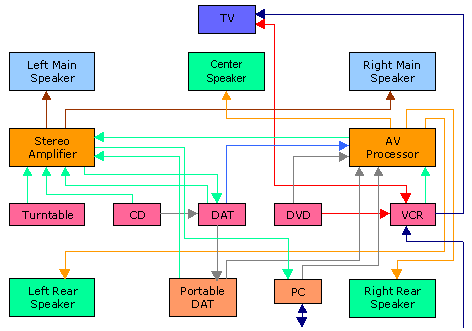
Schematic display of my equipment (click to navigate this page)
|
|
For me there is almost nothing to be banned from my equipment. For example: I combined a pure analog chain (consisting of a turntable with a valve amplifier) and a DVD player with a digital surround processor, keeping in mind that it is fun to listen to surround music and motion pictures with the right (surround) sound. I even use a CD player, because there is so much music that is only available in CD format although the turntable sounds better.
Another thing are the costs. There are many other manufacturers of audiophile equipment, that produce "better" equipment than mine. My main goal when buying the stuff was to get the best for the price, an affordable High-End equipment. That is not a contradiction. It only takes some time and a dealer that allows you to test the equipment in your listening room.
The most important thing when trying to improve the sound of an existing equipment is the room acoustics not the cables not anything else. The placement of the speakers has to be changed and tested. The difference between an High-End and a normal system IMHO is not the value of the equipment but the care that has been taken into the placement and selection of the speakers.

At some stage in my life (I must have been bored somehow) I can't remember when it was I sat down at my computer and entered all my CD's LP's and DAT's into a textprocessor. Later I transferred the file to HTML and put it on a web page (that was in 1993). When I designed this pages it was natural for me to look for some contents and the old data was redesigned to fit into the new design (CSS were added).
Now if you want to browse my record collection just click on one of the letters below and have a look. It is still outdated but I will try to add my latest records one by one. This lists will never be finished.
A
B
C
D
E
F
G
H
I
J
K
L
M
N
O
P
Q
R
S
T
U
V
W
X
Y
Z
To evaluate new HiFi components I always use the same set of recordings, to be able to compare different components. It took some time till I got used to this records, but now my memory has stored the sounds and room acoustics of this recordings in a way that I'm most of the time able to compare for example different amplifiers even if can not switch between them.
The main advantage of this records is that they are not one of these "rattle and boom" test records but contain interesting music as well.
In march 2002 there was a discussion in the newsgroup
de.rec.musik.hifi asking every reader of the group to tell which are
the 5 best records that are used to evaluate hifi components.
This discussion resulted in an interesting list of suggestions.
Click
 here
to read what the usenet audio specialists suggested (only available in german).
here
to read what the usenet audio specialists suggested (only available in german).
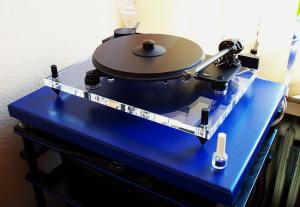
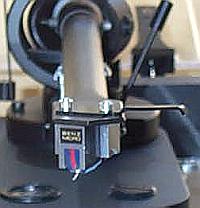
I think that the analog sound reproduction systems can be superior
to the digital ones. Although my old
Dual
CS 606 turntable with the
 Ortofon
ULM cartridge was not good at all (there were better ones but at the time I bought it
I couldn't afford one), I like to listen to my old vinyl records
and sometimes I think the sound reproduction of this old medium
is better than their digital equivalents even on this old turntable.
To improve my stereo equipment I now use a
Ortofon
ULM cartridge was not good at all (there were better ones but at the time I bought it
I couldn't afford one), I like to listen to my old vinyl records
and sometimes I think the sound reproduction of this old medium
is better than their digital equivalents even on this old turntable.
To improve my stereo equipment I now use a
 Pro-Ject Audio Systems
Perspective turntable with a
Pro-Ject Audio Systems
Perspective turntable with a
 Benz Micro
MC Silver high output moving coil cartridge
since the 22nd Dec. 2000. This is definitely a quantum leap forward in the quality of sound
reproduction for my equipment. Although the cartridge is not prepared yet,
my old vinyl records now sound like they have never sounded before.
Vocals are presented in a way that you think the singer is right in your listening room.
Acoustic basses are now accurately reproduced.
After 72 hours of listening the Perspective has been readjusted.
Actually the weight adjustment was changed during this period
as well as the Anti-Skating. The cartridge should now be fine as well.
The sound of the turntable now is "at it's best".
Benz Micro
MC Silver high output moving coil cartridge
since the 22nd Dec. 2000. This is definitely a quantum leap forward in the quality of sound
reproduction for my equipment. Although the cartridge is not prepared yet,
my old vinyl records now sound like they have never sounded before.
Vocals are presented in a way that you think the singer is right in your listening room.
Acoustic basses are now accurately reproduced.
After 72 hours of listening the Perspective has been readjusted.
Actually the weight adjustment was changed during this period
as well as the Anti-Skating. The cartridge should now be fine as well.
The sound of the turntable now is "at it's best".
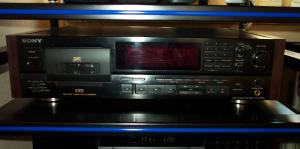
I now use a
 Sony
DTC-57 ES and a TCD-03 portable player. Both needed to be repaired.
The 57 ES refused to rewind the tape, and the portable player
always showed error messages in it's display and refused to play any
tape at all. Both were not able to play a tape that was recorded on the other
machine. I sent them both to Sony in Germany with a complete description of the
errors and they were repaired for about 400€. Now they work fine.
I use them to make copies of my friends LP's at 48khz. Some of the
sounds of an LP can actually be captured on DAT, although it is not as good
as a turntable, but for sure it is better than CD (at least most of the time).
A nice feature of the DTC-57 ES is that it can work
as an high quality analog to digital converter (ADC).
Just press the record-button with no tape in the player and it'll simlpy work
as an ADC sending the analog input as a digital output stream
to the coaxial and TOSLINK output.
Sony
DTC-57 ES and a TCD-03 portable player. Both needed to be repaired.
The 57 ES refused to rewind the tape, and the portable player
always showed error messages in it's display and refused to play any
tape at all. Both were not able to play a tape that was recorded on the other
machine. I sent them both to Sony in Germany with a complete description of the
errors and they were repaired for about 400€. Now they work fine.
I use them to make copies of my friends LP's at 48khz. Some of the
sounds of an LP can actually be captured on DAT, although it is not as good
as a turntable, but for sure it is better than CD (at least most of the time).
A nice feature of the DTC-57 ES is that it can work
as an high quality analog to digital converter (ADC).
Just press the record-button with no tape in the player and it'll simlpy work
as an ADC sending the analog input as a digital output stream
to the coaxial and TOSLINK output.
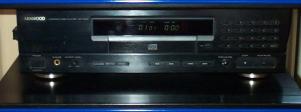
My last dedicated CD player was a
 Kenwood
DP-7030. It is build up with discrete electronics were everything is dimensioned
a bit bigger than it has to be. That makes this player one of the best sounding of that time
for the price. One day it refused to play any CD.
I thought there could be dirt on the laser. So I opened it and cleaned
it with 99% alcohol. That worked fine.
Kenwood
DP-7030. It is build up with discrete electronics were everything is dimensioned
a bit bigger than it has to be. That makes this player one of the best sounding of that time
for the price. One day it refused to play any CD.
I thought there could be dirt on the laser. So I opened it and cleaned
it with 99% alcohol. That worked fine.
Unfortunately it broke in June 2003 in a very spectecular way. Flames were coming out
of the venting holes on the right hand side of the CD player. Luckily I was
there when it happened, and I was able to prevent the CD player from
buring down my appartment. That should never happen with any electronic equipment.
I now suggest: first not to buy any Kenwood equipment at all and second to switch off
any electronic equipment when you leave your appartment. If that is not possibe, because
the equipment can not be switched off (standby mode only) to remove it from the current.
I had the opportunity to test other components as well:
This was my first player, and I had tears in my eyes when it
broke in 1988. It was one of the first players available and
really bomb proof. At that time they only used 14 of the available
16 bits resolution stored on a CD but they were the first to use
four times oversampling.
The
 Philips
CD204 created a soft sound image, that
I liked very much in contrast to the Sony players at that time.
I would still use it but it could not be repaired anymore.
Philips
CD204 created a soft sound image, that
I liked very much in contrast to the Sony players at that time.
I would still use it but it could not be repaired anymore.
A low cost low budget player, that is for sure worth the money. The major disadvantage of this CD player is that it creates click sounds and drop-outs whenever one touches the player. Means the laser pickup reacts very sensible on shock.
Buying an amplifier can not be seperated from the speakers the you plan to use. There shere power of an amplifier says nothing on how it will sound together with a speaker. As a rule of thumb one can say that it's a good idea to select the amplifier in a way that it's far more powerful than the maximum allowed for the speaker. This type of combination will for sure not destroy your speakers as long as you don't turn the amplifier to maximum volume. The other way round is far more dangerous. Using a low power amp to drive large speakers, will force the amp to always work on it's limit. Driven this way the amplifier will create high-frequency distortions at high volume that can destroy your speakers. But this is only a rule of thumb.
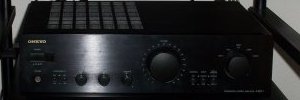
After the AMC Amplifier finally broke down (see below) I had to do something and buy
an amplifier that does not create open fire in my living room anymore. It had to have
a moving magnet turntable input for my Project Perspective and it would be nice
if it could be remotely controlled via infrared RC-unit. And still it had to be cheap.
A friend of mine had a used
 Onkyo
A-9921 Amplifier that he did not use anymore.
He bought a Yamaha AX amplifer and did not use the Onkyo anymore.
Luckily he sold it to me. Well actually
it was more a gift than anything else. Unfortunately I had to realize that the balance
between the left and right channel wasn't ok, but that could be fixed.
Well this amlifier is a beautiful sounding part. Especially the MM-Input works nicely
with the high output Moving Coil Banz cartridge. I'm quite satified with its performance.
Onkyo
A-9921 Amplifier that he did not use anymore.
He bought a Yamaha AX amplifer and did not use the Onkyo anymore.
Luckily he sold it to me. Well actually
it was more a gift than anything else. Unfortunately I had to realize that the balance
between the left and right channel wasn't ok, but that could be fixed.
Well this amlifier is a beautiful sounding part. Especially the MM-Input works nicely
with the high output Moving Coil Banz cartridge. I'm quite satified with its performance.
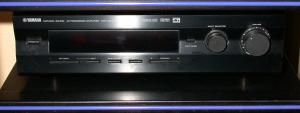
Because the main goal when choosing my equipment was the
improvement of the stereo music reproduction, and I'm
quite satisfied with how it sounds, it became clear
that when adding equipment for surround sound I
would not change the existing amplifier/speaker combination.
The only solution would be to buy an extra processor/amplifier
for the surround sound. The
 Yamaha
DSP E-800 is exactly what I have been looking for.
It has three digital and lots of analog inputs,
a Dolby ProLogic, Dolby Digital (AC3) and DTS processor
and adds three main amplifiers for the rear and center speakers.
Actually I use a dedicated
Yamaha
DSP E-800 is exactly what I have been looking for.
It has three digital and lots of analog inputs,
a Dolby ProLogic, Dolby Digital (AC3) and DTS processor
and adds three main amplifiers for the rear and center speakers.
Actually I use a dedicated
 Heco
D'Appolito Signature center speaker although the
Maggies
already produce an excellent sound from between
the speakers. It was difficult to find a center that fits
the sound of the
Maggies
and it took quite some time and efford to find one.
A different sound on the rear channel speakers is not that important
and can (but must not) be tolerated. An excellent solution are the
Heco
D'Appolito Signature center speaker although the
Maggies
already produce an excellent sound from between
the speakers. It was difficult to find a center that fits
the sound of the
Maggies
and it took quite some time and efford to find one.
A different sound on the rear channel speakers is not that important
and can (but must not) be tolerated. An excellent solution are the
 Heco
D'Appolito Signature rear speakers.
Heco
D'Appolito Signature rear speakers.
Setting up the volume and time delay for a multichannel AV processor proves to be another problem. Usually the factory settings of the time delay and volume is not correct and the user manuals have little to nothing to say about how to set it up. The system has to be readjusted every time you change the position of the speakers or your listening position.
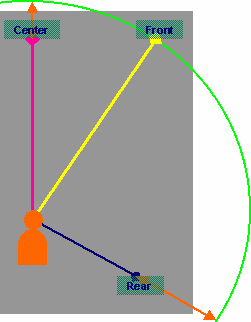
You'll have to measure the distances between your listening position and every speaker. The optimal result would be if they are all the same (green circle). In this case the delay for the center and rear speakers would be 0[ms]. Because of the structure of the listening room this will almost never be the case. Usually the rear and the center speakers will be closer to you listening position than the main speakers. That's where the delay in the setup of the A/V processor comes into play. Sometimes the delay for the center can not be controlled. In this case you'll have to move your center a bit closer to the wall (or your main speakers closer to the listening position), ending somewhere on the green line. (note that in the example to the right the only solution would be to move the main speakers a bit closer to the listening position). To give an example: let's say the distance from the listening position to the main speaker is 3.0[m] (yellow line), the center is 2.7[m] (pink line) and the rear speakers 1.7[m] (blue line).
Now you can calculate the differences to the optimal green line which is 3.0[m]-2.7[m] giving 0.30[m] (red arrow) for the center and 3.0[m]-1.7[m] giving 1.3[m] (red arrow) for the rear speakers. Now you'll have to know that the speed of sound is approximately 340[m/s]. Now divide the difference by the speed of sound. That means: 0.3[m]/340[m/s]=0.00088[s] (rounded 0.001[s]) and 1.3[m]/340[m/s]=0.0038[s] (rounded 0.004[s]).
The sound of the center will reach you 1/1000[s] (equivalent to 1 millisecond) and of the rear 4/1000[s] (4 milliseconds) earlier than of the main speakers.
These are the values to enter as delay time for the center and the rear speakers in the Dolby ProLogic, AC3 (Dolby Digital) or DTS setup of the A/V processor. You're not finished yet. The next task will be to adjust the volume.
There is no way to set up the volume of the speakers but to use a sound level meter. Go buy one, ask a friend or your hifi dealer if he's so kind to give it to you.
Switch it's weighting to dB(C) mode (linear frequency)
and the response to slow (accumulation of values).
Now use a test DVD to generate a noise signal for each channel.
I use the THX test included on the
" Star Wars Episode 1 The Phantom Menace".
Note: the built-in noise generators of the A/V processor are
most of the time not as exact as they need to be, so simply don't use them.
Now sit down in your listening position placing the
sound level meter in the position where usually your head would be.
Star Wars Episode 1 The Phantom Menace".
Note: the built-in noise generators of the A/V processor are
most of the time not as exact as they need to be, so simply don't use them.
Now sit down in your listening position placing the
sound level meter in the position where usually your head would be.
Adjust the microphone of the sound level meter to the direction where the sound comes from and adjust the volume of this channel in the setup of the AV processor accordingly. Repeat this for every channel. Each speaker must create the same volume in your listening position. If this is the case, your A/V processor is properly configured and the audio setup is finished.
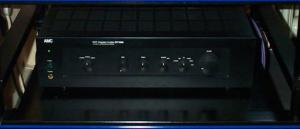
It took me one year to find an amplifier that was able to reproduce
the sound the way I like it and still be affordable.
I decided to buy an
 AMC
CVT 3030 integrated amplifier
with a MOS FET pre amp and a valve main amp.
It is both an affordable and an incredible sounding amplifier.
Anyway, If you are looking for an easy to use and stable amp, this
is definitely not the amplifier you should look for.
It had to be repaired four times until my dealer replaced it
with a new one. In January 2000 it had to be repaired again because
the amplifier got so hot that the valves got loose!
But that wasn't the last problem.
AMC
CVT 3030 integrated amplifier
with a MOS FET pre amp and a valve main amp.
It is both an affordable and an incredible sounding amplifier.
Anyway, If you are looking for an easy to use and stable amp, this
is definitely not the amplifier you should look for.
It had to be repaired four times until my dealer replaced it
with a new one. In January 2000 it had to be repaired again because
the amplifier got so hot that the valves got loose!
But that wasn't the last problem.
The reason for the last repair of the amplifier was that the right
channel simply faded away till nothing could be heard anymore.
The right channel created no sound regadeless of the selected input source.
I realized that the valves on the right hand side of the amp did not glim
anymore. The preamplifier seemed to work.
I phoned up my dealer and he told me that AMC has got
an upgrade kit, that will cost about 300 €.
That was too much and I phoned up
 Eclectic Audio
the german distributor of AMC
products. The owner told me that this is a known problem of the
old AMC valve amplifiers. The cable that connects the power board with
the heating of the valves simply was designed too small (as well as the connectors).
I could see that the connector of the heating on the right side has got
a brown color as if it has become extremely hot
(in contrast to the connector for the left channel).
He told me to try to connect it with a new cable with a diameter of at least 1.5mm.
I tried it out and that solved the problem.
Eclectic Audio
the german distributor of AMC
products. The owner told me that this is a known problem of the
old AMC valve amplifiers. The cable that connects the power board with
the heating of the valves simply was designed too small (as well as the connectors).
I could see that the connector of the heating on the right side has got
a brown color as if it has become extremely hot
(in contrast to the connector for the left channel).
He told me to try to connect it with a new cable with a diameter of at least 1.5mm.
I tried it out and that solved the problem.
Finally in 2004 this amplifier again catched fire and burned down. It could not be repaired anymore.
The
 Onkyo
TX-7730 Receiver works well with the Castle and
Onkyo
TX-7730 Receiver works well with the Castle and
 NHT
speakers.
Unfortunately it hasn't got a "Direct" switch, but nevertheless
it is an affordable and good sounding amplifier, that is
easy to use and maintain (in contrast to my AMC amp). The speakers should
not be too demanding because the amp simply switches off the speaker
for security reasons. I used it as a working horse in my audio setup.
NHT
speakers.
Unfortunately it hasn't got a "Direct" switch, but nevertheless
it is an affordable and good sounding amplifier, that is
easy to use and maintain (in contrast to my AMC amp). The speakers should
not be too demanding because the amp simply switches off the speaker
for security reasons. I used it as a working horse in my audio setup.
Selecting a new set of speakers can not be seperated by the amplifier you plan to use. They can only be tested together. It does not make sense to listen to new speakers when they are connected to another amplifier. So take the amp with you when you're going to listen to new speakers, or even better tell your dealer to build up a selection of speakers in your listening room. The amplifer/speaker combination dominates the sound quality of your equipment far more then any other unit like CD, the turntable or cables or anything else. Another hint: speakers usually need room. Although some of them are called cabinet speakers, it is a good idea to put them on a stand with a little (or more) room between the speaker and the back and side wall. Although some speakers are designed (in tonality) to even be wall mounted they usually benefit from the room by producing a more accurate (mostly larger) soundstage.
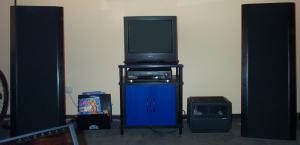
When I bought the amplifier I had to also look for a new set of
speakers. I'm now satisfied with the reproduction capabilities of my
 Magnepan
MG 1.5 Special Edition Magneplanar bipolar speakers (Maggies).
They reproduce the room of a record in a way only
bipolar speakers can, by sending the music signal both to the
listener as well as the back wall. That creates reflections in the
listening room that puts the recording acoustics right in your living room.
These magnetostats do not demand much from the amplifier in contrast to
most electrostatic speakers.
It is no problem to use a valve amplifier to drive the Maggies.
The placing in the living room is a major problem. The minimum
distance to the back wall should be 0.62[m], 0.8[m] is better. I suggest you not to place them
parallel to the back wall, but to slightly point to the listening
position. Another hint is not to place the Maggies in a 60 degree triangle
with the listening position, but to move them a bit closer together.
That makes the soundstage even more accurate.
Magnepan
MG 1.5 Special Edition Magneplanar bipolar speakers (Maggies).
They reproduce the room of a record in a way only
bipolar speakers can, by sending the music signal both to the
listener as well as the back wall. That creates reflections in the
listening room that puts the recording acoustics right in your living room.
These magnetostats do not demand much from the amplifier in contrast to
most electrostatic speakers.
It is no problem to use a valve amplifier to drive the Maggies.
The placing in the living room is a major problem. The minimum
distance to the back wall should be 0.62[m], 0.8[m] is better. I suggest you not to place them
parallel to the back wall, but to slightly point to the listening
position. Another hint is not to place the Maggies in a 60 degree triangle
with the listening position, but to move them a bit closer together.
That makes the soundstage even more accurate.
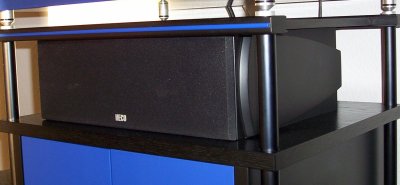
It is not that easy to find speakers that fit the sound of the Maggies, except for other Maggies, but they simply are too expensive and the Rear/Center speaker set that is offered by Magnepan is not suitable for Dolby Digital or DTS.
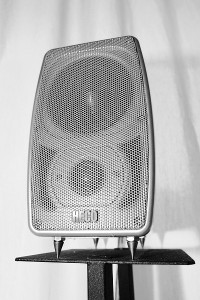
I tried several other speakers. One of which are the
 Heco
Horizon 110, the Heco D'Appolito-Signature Rear and Center speaker
and the
Heco
Horizon 110, the Heco D'Appolito-Signature Rear and Center speaker
and the
 Castle
speakers.
The Heco D'Appolito-Signature speaker set
is the only dedicated surround set I've tested
to fit to the sound of the
Maggies.
I now use the center speaker
in surround setup and I'm impressed by its
performance. Simply excellent, and a good combination
with the
Maggies.
But you'll need a powerful amplifier
for the center speaker.
As a rear speaker I use the Heco Horizon 110.
I had the opportunity to have a look at the Horizon prototype.
They are supposed to be the "Elac" killers, the first
speakers that can cope with Elac's Jet tweeter.
They are not designed as rear but as stereo speakers.
They come with a two way system in an alloy cabinet. Unfortunately
the prototypes were not fully functional. Now that I've got
the end-user version they replaced the Heco D'Appolito-Signature rear speakers.
Castle
speakers.
The Heco D'Appolito-Signature speaker set
is the only dedicated surround set I've tested
to fit to the sound of the
Maggies.
I now use the center speaker
in surround setup and I'm impressed by its
performance. Simply excellent, and a good combination
with the
Maggies.
But you'll need a powerful amplifier
for the center speaker.
As a rear speaker I use the Heco Horizon 110.
I had the opportunity to have a look at the Horizon prototype.
They are supposed to be the "Elac" killers, the first
speakers that can cope with Elac's Jet tweeter.
They are not designed as rear but as stereo speakers.
They come with a two way system in an alloy cabinet. Unfortunately
the prototypes were not fully functional. Now that I've got
the end-user version they replaced the Heco D'Appolito-Signature rear speakers.
I've also tested some other speakers not only if they are able to work as rear speakers for surround sound but as dedicated stereo speakers.
My former girlfriend's first choice were the
 Castle
Trent II speakers.
They use a two way system to reproduce accurate bass sound
without sounding too "thick".
Connected to the DSP in a surround environment with the
Maggies
comparing the pink noise reveals that the the
Castle speakers are excellent as main (cabinet) speakers but
sound slightly different with the main difference
in the lower vocal frequency range. The difference is not too
annoying but is there.
The Castle speakers are not magnetically shielded so be sure to leave
some space between the TV set and the speaker(s) to prevent
the TV from being damaged.
They are the best low budget speakers I know of. It is a good idea
to place them near a wall but not in a corner of your listening room.
Castle
Trent II speakers.
They use a two way system to reproduce accurate bass sound
without sounding too "thick".
Connected to the DSP in a surround environment with the
Maggies
comparing the pink noise reveals that the the
Castle speakers are excellent as main (cabinet) speakers but
sound slightly different with the main difference
in the lower vocal frequency range. The difference is not too
annoying but is there.
The Castle speakers are not magnetically shielded so be sure to leave
some space between the TV set and the speaker(s) to prevent
the TV from being damaged.
They are the best low budget speakers I know of. It is a good idea
to place them near a wall but not in a corner of your listening room.
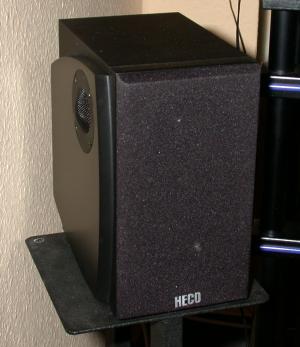
As long as Heco wasn't able to deliver the Horizon 110 I used the D'appolito rear speakers. They were not bad, but not as good as the Horizon 110.
These speakers need room. Place them at least 60cm away from
the wall. I stuffed the venting of the bass to make it more accurate.
Their glossed black laminated surface makes them an eye-catcher in
your living room.
They are very good speakers but unfortunately they are quite expensive.
 NHT
offers a surround set for these speakers
with an additional active subwoofer.
But be warned, the build-in bass in the Super Two IMHO is enough.
There is no need to buy an additional subwoofer for surround sound and
stereo music reproduction.
NHT
offers a surround set for these speakers
with an additional active subwoofer.
But be warned, the build-in bass in the Super Two IMHO is enough.
There is no need to buy an additional subwoofer for surround sound and
stereo music reproduction.
Although the
 Acoustic Research
sound in no way spectecular or impressive, I like them especially because
of their soft, non aggressive sound. Even when they are used at low
volume they create a wide and accurate sound stage. They do not
demand much from the amplifier, means they create an
good sound (almost) regardless from the type of amplifier used.
So when one wants to enhance the sound of an existing (low) budget stereo
amplifier/speaker set, it is a excellent idea to take
the Acoustic Research Status S30 into consideration.
Because the bass created by the S30 is quite intense, I suggest to think
about leaving some space between the speaker and the wall or
stuff the ventilation of the bass-reflex tube.
Acoustic Research
sound in no way spectecular or impressive, I like them especially because
of their soft, non aggressive sound. Even when they are used at low
volume they create a wide and accurate sound stage. They do not
demand much from the amplifier, means they create an
good sound (almost) regardless from the type of amplifier used.
So when one wants to enhance the sound of an existing (low) budget stereo
amplifier/speaker set, it is a excellent idea to take
the Acoustic Research Status S30 into consideration.
Because the bass created by the S30 is quite intense, I suggest to think
about leaving some space between the speaker and the wall or
stuff the ventilation of the bass-reflex tube.
A friend of mine uses the impressive AR Status S50 as front, the AR Status SC2 center speaker and the AR Status S30 as rear speakers. I'll write my and his experiences here as soon as I am able to test this environment. It looks as if this is a good combination. This setup for sure doesn't need a subwoofer (although one is offered by AR).
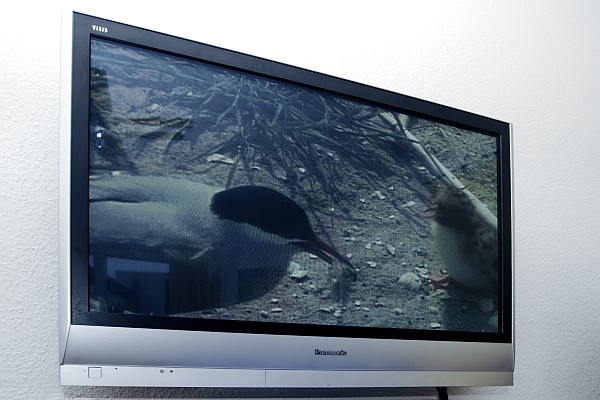
I now use a
 Panasonic
TH 42 PV60 HD-Ready plasma TV set with 42" (equiv. 106cm). Even in the 2.35/1 aspect ratio it still has a diameter of 100cm.
It uses the G9 panel and advanced Signal processing to create a stunnig image quality even for cable TV.
I connect my laptop computer to the plasma display to create and show slideshows of my digital images.
Panasonic
TH 42 PV60 HD-Ready plasma TV set with 42" (equiv. 106cm). Even in the 2.35/1 aspect ratio it still has a diameter of 100cm.
It uses the G9 panel and advanced Signal processing to create a stunnig image quality even for cable TV.
I connect my laptop computer to the plasma display to create and show slideshows of my digital images.
I also used a
 Sony
KV-21T2D and a KV-1400 (the old one) television set.
I chose a mono TV because normally I used a stereo VCR and surround DVD
player to create a stereo sound via the stereo amplifier (and the surround processor).
So there was no need to spend the money for a stereo TV set.
Sony
KV-21T2D and a KV-1400 (the old one) television set.
I chose a mono TV because normally I used a stereo VCR and surround DVD
player to create a stereo sound via the stereo amplifier (and the surround processor).
So there was no need to spend the money for a stereo TV set.
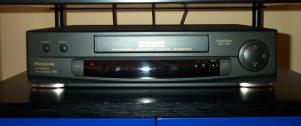
To have a look at music videos I bought a
 Panasonic
NV-HD 610 Stereo Video recorder and connected it to my stereo equipment.
Unfortunately the musical capabilities of this systems are limited
by design. The rotating recording/playback head creates a click sound
that can be heard.
Panasonic
NV-HD 610 Stereo Video recorder and connected it to my stereo equipment.
Unfortunately the musical capabilities of this systems are limited
by design. The rotating recording/playback head creates a click sound
that can be heard.
It's okay for videos and motion pictures. It's definitely insufficient for stereo music reproduction. I don't know if this is a failure in my component or a general problem with all VCR's. Actually if you're looking for a system that reproduces music videos take a look at DVD players. In 2001 the VCR broke. It refused to accept any tape and threw it out. It sometimes showed the error message F03 or F04. Panasonic told me that it is a known problem and that most propably the "Mode Select Switch" is broken. I didn't use the VCR that much, so when you are looking for a (new) VCR, consider a different VCR and/or manufacturer.
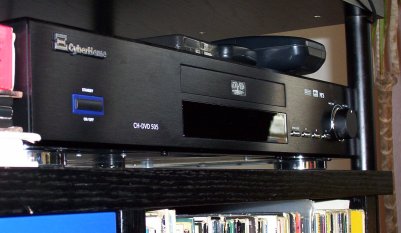
I now use a
 Cyberhome
CH-DVD 505 combined CD and DVD Player. Because of its dual laser pickup it is an inrcedible sounding
DVD and CD player. It is again connected to the AV Processor via the digital TOSLINK cable
as well as via the coaxial cable and via the 2 channel RCA connector to the valve amplifier.
Cyberhome
CH-DVD 505 combined CD and DVD Player. Because of its dual laser pickup it is an inrcedible sounding
DVD and CD player. It is again connected to the AV Processor via the digital TOSLINK cable
as well as via the coaxial cable and via the 2 channel RCA connector to the valve amplifier.
I once used a low end Scott 837 DVD player that supports CD,DVD (both RW) and is capable of displaying Kodak Photo CDs,
mp3, jpeg, VCD and S-VCD. It is connected to the AV processor using a coaxial digital cable that
keeps the decoding of Prologic, DTS or Dolby Digital up to the more expensive and better AV processor.
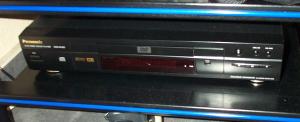
I formerly used the Digital Versatile Disk player
 Panasonic
DVD-RV20 and added it to my equipment using my AMC amplifier.
The first thing I checked was how good does it sound to send
a Dolby Digital 5.1 signal through my stereo equipment.
Well don't do it, I think because there's too much reverberations
in the music signal the room becomes too large. I cross checked
it with my friends Dolby DTS/ES/EX equipment and there it was okay.
Because my first DVD Fleetwood Mac "The Dance" has got two sides,
side one with Dolby Digital 6 channel remix and the other side
with 48kHz (sampling frequency) uncompressed PCM stereo mix, I was able to compare
the two versions. On the other hand I compared the ability of this DVD
player to play CD's to
my CD player.
The result is that it is a terribly
bad idea to use this DVD player as a substitute for a dedicated
CD player. Tonality is not OK, female voices sound like
they are singing behind a carpet. Lower bass frequencies are
not reproduced correctly and high frequencies simply become too intense.
I now use a 10m TOSLINK cable to connect the DVD player with the
AV processor.
Panasonic
DVD-RV20 and added it to my equipment using my AMC amplifier.
The first thing I checked was how good does it sound to send
a Dolby Digital 5.1 signal through my stereo equipment.
Well don't do it, I think because there's too much reverberations
in the music signal the room becomes too large. I cross checked
it with my friends Dolby DTS/ES/EX equipment and there it was okay.
Because my first DVD Fleetwood Mac "The Dance" has got two sides,
side one with Dolby Digital 6 channel remix and the other side
with 48kHz (sampling frequency) uncompressed PCM stereo mix, I was able to compare
the two versions. On the other hand I compared the ability of this DVD
player to play CD's to
my CD player.
The result is that it is a terribly
bad idea to use this DVD player as a substitute for a dedicated
CD player. Tonality is not OK, female voices sound like
they are singing behind a carpet. Lower bass frequencies are
not reproduced correctly and high frequencies simply become too intense.
I now use a 10m TOSLINK cable to connect the DVD player with the
AV processor.
I use a
 Medion
MD6179 (2GHz P4 mobile)
laptop computer
that is connected to the internet
to be able to download, hear and buy music that is stored on CD, DVD, LP, DAT or video.
I prefer the
Medion
MD6179 (2GHz P4 mobile)
laptop computer
that is connected to the internet
to be able to download, hear and buy music that is stored on CD, DVD, LP, DAT or video.
I prefer the
 MusicMatch
Jukebox software for converting to mp3 and the Ahead Nero software for ripping analog media especially LPs
to digital media. The MD6179 connected to the Digital signal processor using a
optical cable with a TOSLINK connector on one side and a miniplug on the other (laptop) side.
MusicMatch
Jukebox software for converting to mp3 and the Ahead Nero software for ripping analog media especially LPs
to digital media. The MD6179 connected to the Digital signal processor using a
optical cable with a TOSLINK connector on one side and a miniplug on the other (laptop) side.
The most controversial part of the stereo equipment are the cables. Most people insist that there is no difference in sound between different cables especially when it comes to the digital ones.
Most people think that the standard cables that come with the products are sufficient. But most of the time the diameter as well as the connectors limit the musical capabilities of the stereo equipment. Even self-made cables with with more expensive connectors will for sure improve your stereo equipment. As a general rule one can say that a cable that creates a stunning change in the sound of your equipment is not an improvement but only an effect. One can not give general rules for the purchase of cables, because the change of sound heavily depends on the equipment you use and the room acoustics. So almost everybody has to test the cables on his own. But you never experienced how good your equipment can sound when you haven't connected it with appropriate cables.
When it comes to the beyond 200€ for the stereo meter then
things become difficult. One may discover certain effects that
(in a first view) may be an improvement, but after some time
simply are more "special effects" than a real improvement.
I use
 Burmester
Lila,
Burmester
Lila,
 Audioquest
Quartz, a
Audioquest
Quartz, a
 Thorens
phono cable and some self-made cables with 24ct. gold plated connectors to increase the quality of the connection.
Thorens
phono cable and some self-made cables with 24ct. gold plated connectors to increase the quality of the connection.
I use customized
 Oehlbach
Stream speaker cable with a diameter of 4.0mm for the center and
rear speakers and 6.0mm for the
Maggies.
It is a good idea not to stuff the cable directly into the amplifier
and the speakers but to use connectors instead because
the cable oxidates after some time and the connection becomes
less tight when used without connectors.
I use 24ct. gold plated Oehlbach cable lug to connect the
cable to the speakers and the amplifiers.
That makes it easy to exchange the speakers and the connection quality
does not degrade over time.
Oehlbach
Stream speaker cable with a diameter of 4.0mm for the center and
rear speakers and 6.0mm for the
Maggies.
It is a good idea not to stuff the cable directly into the amplifier
and the speakers but to use connectors instead because
the cable oxidates after some time and the connection becomes
less tight when used without connectors.
I use 24ct. gold plated Oehlbach cable lug to connect the
cable to the speakers and the amplifiers.
That makes it easy to exchange the speakers and the connection quality
does not degrade over time.
I use TOSLINK optical digital cables. I compared a one meter Denon cable to a 10 meter noname TOSLINK cable and couldn't hear any reproducible difference. A friend of mine compared a coaxial digital cable with a TOSLINK and we were both able to hear a difference. The sound created by the coaxial cable had more room acoustics, the soundstage seemed larger. Unfortunately I was not able to tell which one was which during a blind test, so I think there is a difference between optical and coaxial connections (at least in his configuration) and the coaxial connection was superior to the optical connection, but the changes in sound is marginal and can be ignored (at least compared to the changes in sound that can be achieved changing the LF cables). Nevertheless to connect the DAT player with the Digital Sound Processor I use a self made coaxial cable (RG58U) with noname gold plated RCA connectors. The RG58U seems to be a good cable for digital coaxial connections. I started using it as a digital data transmitter for ethernet (cheapernet) networks up to a maximum length of 300 meters. I still had a few meters left and built a digital audio cable out of it. It sounds quite nice. I was not able to hear any difference to an expensive factory made cable.
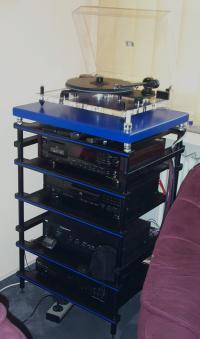
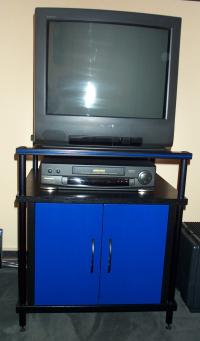
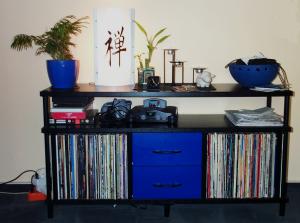
After having trouble putting my equipment in a rack where the stands
were made off glass (it sounded terrible),
I decided to buy a dedicated hifi-rack. I now use a modified
 Creaktiv
Audio 4 for my hifi equipment with an absorber stand for the
turntable,
a customized Audio 2 system for the center speaker and the
TV
and a modified LP3 as a sideboard for my
LP's,
DAT's,
VCR
and
DVD.
I never thought it would make a difference. I bought it because of its
versatilely, but when I switched on my amplifier
and put the first CD in the player it was not only a difference but
an incredible improvement. I think the valve amplifier really benefits
from the rack.
Creaktiv
Audio 4 for my hifi equipment with an absorber stand for the
turntable,
a customized Audio 2 system for the center speaker and the
TV
and a modified LP3 as a sideboard for my
LP's,
DAT's,
VCR
and
DVD.
I never thought it would make a difference. I bought it because of its
versatilely, but when I switched on my amplifier
and put the first CD in the player it was not only a difference but
an incredible improvement. I think the valve amplifier really benefits
from the rack.
There are several audiophile web pages in the internet
created and maintained by audio enthusiasts.
Try any of the well known search engines to find them.
As a better alternative for my Record Collection
I can suggest you to have a look at the
more complete databases:
 All Music Guide,
All Music Guide,
 MusicLine
and
MusicLine
and
 Gracenote.
Please also have a look at the
de.rec.music.hifi
usenet discussion group, its
Gracenote.
Please also have a look at the
de.rec.music.hifi
usenet discussion group, its
 FAQ
(Frequently Asked Questions) and
FAQ
(Frequently Asked Questions) and
 Audiophile Recordings,
a list of Usenet articles of
de.rec.music.hifi
where the authors write about what records they use to evaluate new
components (only available in german).
Audiophile Recordings,
a list of Usenet articles of
de.rec.music.hifi
where the authors write about what records they use to evaluate new
components (only available in german).
The manufacturers of my equipment are:
 Ortofon
and
Ortofon
and
 Benz Micro
Cartridges
Benz Micro
Cartridges
 Pro-Ject Audio Systems
Turntables
Pro-Ject Audio Systems
Turntables
 Sony
Digital Audio Tapes and TV sets
Sony
Digital Audio Tapes and TV sets
 Kenwood
CD player
Kenwood
CD player
 AMC
Amplifier
AMC
Amplifier
 Yamaha
A/D Surround Sound Processor
Yamaha
A/D Surround Sound Processor
 Magnepan and
Magnepan and
 Heco
Speakers
Heco
Speakers
 Panasonic
DVD player and VCR
Panasonic
DVD player and VCR
 Medion
laptop computer
Medion
laptop computer
 MusicMatch
Jukebox MP3 coder/decoder
MusicMatch
Jukebox MP3 coder/decoder
 Burmester
,
Burmester
,
 Audioquest
,
Audioquest
,
 Oehlbach
and
Oehlbach
and
 Thorens
Cables
Thorens
Cables
 Creaktiv
Racks
Creaktiv
Racks
Other manufacturers are:
I'm a member of "The High-End Music and Film webring".
|
||||||